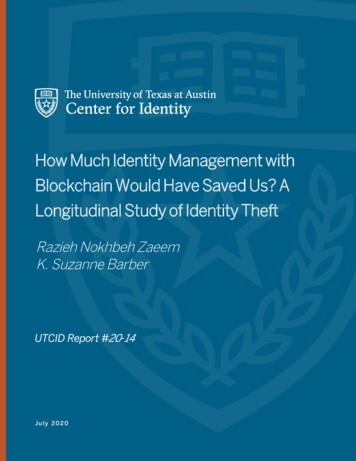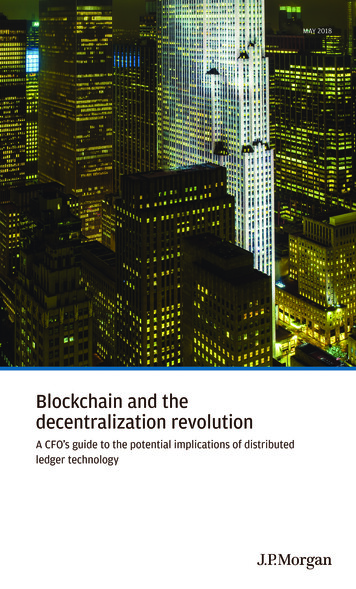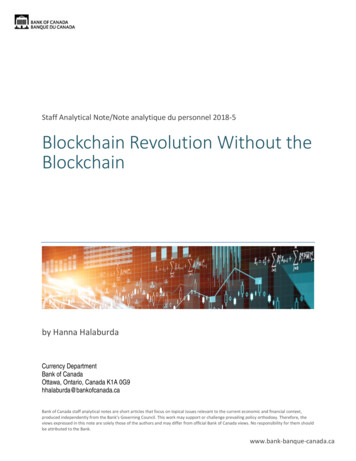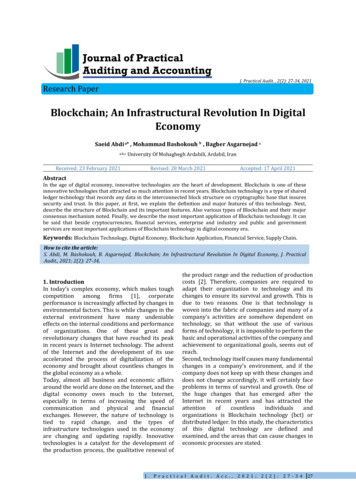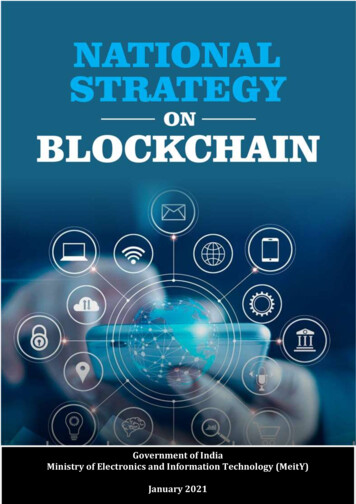
Transcription
Government of IndiaMinistry of Electronics and Information Technology (MeitY) 1January 2021
Table of Contents1.ABSTRACT . 42.OVERVIEW OF BLOCKCHAIN TECHNOLOGY AND APPLICATIONS. 52.1INTRODUCTION . 52.2IMPORTANCE OF BLOCKCHAIN TECHNOLOGY. 62.3ARCHITECTURE OPTIONS . 62.4POTENTIAL BLOCKCHAIN APPLICATIONS OF NATIONAL INTEREST . 72.5VALUE ADDITION FOR BLOCKCHAIN IN E-GOVERNANCE . 83.GLOBAL EFFORTS . 104.FORECAST . 125.NATIONAL SCENARIO . 146.CHALLENGES TO THE ADOPTION OF BLOCKCHAIN TECHNOLOGY . 156.1TECHNOLOGICAL CHALLENGES . 156.2LEGAL CHALLENGES IN ADOPTION IN INDIA . 177.SWOT ANALYSIS . 198.ROADMAP FOR BLOCKCHAIN TECHNOLOGY ADOPTION . 209.NATIONAL LEVEL BLOCKCHAIN FRAMEWORK. 229.1NEED FOR NATIONAL LEVEL BLOCKCHAIN FRAMEWORK . 229.2INTEGRATION OF IMPORTANT NATIONAL LEVEL SERVICES TO BLOCKCHAIN . 23eSign . 23ePramaan . 23DigiLocker . 2310.MULTI-INSTITUTIONAL COE FOR NATIONAL LEVEL BLOCKCHAIN FRAMEWORK ANDCOLLABORATING ORGANIZATIONS . 2411.CONCLUSIONS/RECOMMENDATIONS TOWARDS IMPLEMENTING NATIONAL LEVELBLOCKCHAIN FRAMEWORK . 2612.REFERENCES . 282
Table of FiguresFIGURE 1:BLOCKCHAIN NETWORK AND THE PROCESS OF ADDING NEW TRANSACTION TO LEDGER. 5FIGURE 2: BLOCK STRUCTURE . 6FIGURE 3: BLOCKCHAIN ARCHITECTURE OPTIONS . 7FIGURE 4:APPLICATIONS OF BLOCKCHAIN TECHNOLOGY . 7FIGURE 5: FORECAST: BLOCKCHAIN BUSINESS VALUE, WORLDWIDE 2017-2030 (SOURCE: GARTNER 2017) . 12FIGURE 6: FORECAST ON GLOBAL BLOCKCHAIN GOVERNMENT MARKET BY GEOGRAPHY DURING THE PERIOD 2020 – 2027 . 13FIGURE 7: ROADMAP FOR BLOCKCHAIN TECHNOLOGY ADOPTION . 20FIGURE 8: A NATIONAL LEVEL BLOCKCHAIN FRAMEWORK . 22FIGURE 9: MULTI-INSTITUTIONAL COE AND COLLABORATING ORGANIZATIONS. 243
1. AbstractBlockchain is an innovative distributed ledger Technology which was first introduced inthe design and development of cryptocurrency, Bitcoin in 2009 by Satoshi Nakamoto.Blockchain is an amalgamation of various inventions, with a clear business value.Blockchain enables a shared ledger between the various parties involved in businesstransactions, which is going to act as a single source of truth. Blockchain eliminatesthe need for central entity to validate the transactions. As it is based on peer-to-peernetworks, all nodes would involve in validating the transactions rather than dependingon a central entity. The data structure used in Blockchain Technology helps to maintainunchangeable record of transactions in a time sequenced manner. So, BlockchainTechnology improves transparency, immutability and efficiency aspects, which make itunique and potential to use in various application domains.Blockchain can be used in Permissioned and Permission less models. Permissionedmodel has applications in various domains such as healthcare, cyber security,Governance, media, logistics & hospitality, education, legal, energy, smart cities and soon.Globally and nationally various efforts are being made in implementing Blockchainbased applications. PoCs and pilot deployments are successfully carried out. In order toreap the benefits of the technology, there is a need for National level Strategy inBlockchain Technology.This document provides an insight on the strategies for metamorphosing IndianBlockchain ecosystem to make India as one of the leading countries in terms ofharnessing the benefits of this emerging technology by focusing on following aspects:1) Technological Aspectsa) Evolving a National Blockchain Infrastructure for hosting regulatory sandboxthat can be used for building and deploying Blockchain applications.b) Fostering Research & Development to solve challenges related tointeroperability, faster development and security.c) Deploying Production Grade Applications of National interest focusingtowards providing faster, secure, transparent and efficient delivery ofservices to the citizens.d) Awareness and Capacity Building to ramp-up technology insight acrossvarious stake-holders including students, practitioners, management /executives, decision makers and so on.2) Administrative Aspectsa) Implementing appropriate legal and regulatory architectures includingformulation of standards.b) Formulating policies and incentive models for academic, start-ups andindustry for promoting and adopting Blockchain technology.4
2. Overview of Blockchain Technology and Applications2.1IntroductionBlockchain technology is a distributed ledger technology suitable for decentralizedand transactional data shared across a large network of untrusted entities. Thistechnology allows new type of distributed software architecture capable of findingconcurrence on their shared states without need to establish online trust with anycentral entity/participant. All the transactions shared across entities, along with thetimestamp are maintained as records and placed in blocks. These blocks are furtherlinked as Blockchain and stored in a distributed manner across various nodes of thenetwork. Copy of each transaction along with its hash is stored in the ledger sharedacross all participants of the network. Salient properties of the Blockchaintechnology are pseudonymity, cryptographic guarantees, immutability, shared read& write, accountability, transparency and distributed ownership.This technology eliminates the requirement of central entity / third party to validatethe transactions over the peer-to-peer network. Transactions are validated byconsidering the history of transactions stored at each node of the network and theconsensus of the participants, as shown in Figure 1. As the transactions aredistributed over the network, it is tough for adversary to alter the stored data atmajority points. So, decentralized storage provides better security compared tocentralized storage.Figure 1:Blockchain Network and the process of adding new transaction to ledger5
2.2Importance of Blockchain TechnologyBlockchain uses a unique data structure where verification data related to thetransactional records is cryptographically secured against tampering and stored inblocks. Each block contains details of transactions, hash of the previous block,timestamp etc., as shown in Figure 2.Figure 2: Block StructureBlocks are linked with each other, leading to a Blockchain. Linkage across Blocks isalso cryptographically secured and this is stored at every node in the network. Thismakes it a unique solution to the problem of trust in the digital world, leadingtowards decentralized trust. Anything of value can be tracked and traded on aBlockchain network, reducing risk and cutting costs for all involved. Contracts canbe automated through Smart Contracts.2.3Architecture OptionsBlockchain can be set up in either Public / Permission less or Private / Permissionedconfigurations, each of which has its own advantages and disadvantages. Figure 3shows the potential architecture options for Blockchain deployments and depictsthat private Blockchain allow only known entities to join the Blockchain network,while public Blockchain have no central authority (Brant et al 2018).6
Figure 3: Blockchain Architecture options2.4Potential Blockchain Applications of National InterestBlockchain Technology provides transparency, security and efficiency in businessoperations. It enables a layer of trust over Internet in a unique way, which was firsttried for cryptocurrency application, Bitcoin. Blockchain Technology is going torevolutionize the functionality of B2B, G2C, G2G, B2G services corresponding tovarious application domains. It has applications in healthcare, Governance, cybersecurity, automobiles, media, travel, logistics & hospitality, education, legal, energy,smart cities and so on as given in Figure 4.Figure 4: Applications of Blockchain TechnologyFor example, Blockchain is an apt technology for applying to resolve shortcomings ofany Property Record Management System. Immutability in Blockchain can providean assurance to citizens that their property records are never tampered. Important7
events such as registration process can be captured as transaction on Blockchain,which are also timestamped and hence can keep a track of the property as itpropagates from one citizen to another.Potential Blockchain applications of National interest include: Transfer of Land Records (Property Record Management) Digital Certificates Management (Education, Death, Birth, agreements, saledeeds ) Pharmaceutical supply chain e-Notary Service (Blockchain enabled e-Sign Solution) Farm Insurance Identity management Power distribution Duty payments Agriculture and other supply chains eVoting Electronic Health Record Management Digital Evidence Management System Public Service Delivery IoT Device Management and Security Vehicle lifecycle management Chit fund operations administration Microfinance for Self-Help Groups (SHG)2.5Value addition for Blockchain in E-Governance Blockchain can bring lot of value addition in e-Governance: ImprovesTransparency & Accountability, Building Trust with Citizens, Speed uptransactions, Protecting Sensitive Data and Reducing Costs & ImprovingEfficiency. Government procedures require involvement of multiple departmentstowards providing service to the citizens. Seamless data exchange acrossdepartments is an important requirement towards providing efficient servicedelivery. Inter-departmental processes can be tracked using smart contractenabled workflows and shared ledgers. This results in transparency andaccountability in the system. Blockchain being a single source of truth can be used for authentication andverification of all the transactions and data, produced by various governmentdepartments. Blockchain can be used to create and enable smart contracts, supply chains8
for various government processes, trusted inter-department communicationand tamper evident storage. Blockchain can enable the officials to verify the proof of existence ofdocuments by comparing the provided document copy against a versionstored in a Blockchain. Storing the digital artefacts / documents in aBlockchain makes it secure and immune to tampering.9
3. Global EffortsGlobally many countries have launched platforms and services using Blockchaintechnology and many vendors are offering Blockchain as a service to the customers. Blockchain-based Service Network (BSN) initiative of China aims at helpingcompanies and individuals deploy Blockchain applications faster and cheaper.The BSN has components that provide developer tools for applicationdevelopment and focuses on standardizing it across public networks, regionsand business sectors. The thrust is to support digital economy and smart cityinitiatives. European Blockchain Partnership (EBP), aims to use blockchain anddistributed ledger technologies and develop a trusted, secure and resilientEuropean Blockchain Services Infrastructure (EBSI) which will meet thehighest standards in terms of privacy, cybersecurity, interoperability, regulationin applying policies etc. China has introduced an independently developedBlockchain-based identification system for smart city infrastructure. This systemwill assign a unique, global digital ID to Chinese smart cities, aiming to improvethe connectivity and data sharing between these cities. The notary applicationbased on Blockchain in China's offices is functional from April 2019. Keyless Signature Infrastructure (KSI) is a Blockchain technology designed inEstonia and KSI Blockchain is deployed in Estonian government networks, thishelps to prove the authenticity of the electronic data (records) mathematically.They have implemented X-Road which is a "centrally managed distributed DataExchange Layer (DXL) between information systems". Organizations canexchange information over the Internet using X-Road to ensure confidentiality,integrity and interoperability between data exchange parties. United Arab Emirates has “Smart Dubai” initiative, which aims to become the“first city fully powered by Blockchain by 2021,” and enhance everything fromhealth care and education to traffic management and environmentalsustainability. In US, Food and Drug inspection is using Blockchain to address the problem oflack of transparency and security in health data processing. In UK, Foodstandards agency is using Blockchain to track the distribution of meat toenhance food traceability. Brazil government announced to move applications and popular voting ontoEthereum. Brazil is also focusing on public bidding of contracts with thegovernments, on-line bid solution to ensure secure and transparent deals foragriculture applications, student certificates and tracking student performance. Chile uses Ethereum to track the data and finances from the energy grid to resistcorruption and exploitation through transparent, immutable data available forevery citizen to see. Digital IDs in Switzerland are offered and registered onEthereum in 2017. Canada is using Ethereum to provide transparency to the use of government10
grants to ease citizens’ concerns of corruption. Swedan is focusing onconducting real estate deals and Ghana on land registry and cadastral registerbased on the blockchain to collect property taxes on them.Samsung Blockchain Wallet powered by COSMOCHAIN Blockchain hasdeveloped CosmeeDApp for purchasing of contents using cryptocurrency. If acompany utilized information provided or created by customers the informationproviders gets rewards with using Blockchain in a completely transparentmanner.LG Blockchain is specialized for digital authentication, community token andsupply chain management for the enterprise.Amazon Managed Blockchain, Microsoft Azure Workbench, IBMBlockchain, Oracle Blockchain and BlockappsStrato are some of theBlockchain services offered.Cosmos, Polkadot, Aion, Ark, Wanchain, Atomic Swap and Chainlink aresome of the global research initiatives in Blockchain Interoperability.11
4. ForecastBlockchain Business Value, Worldwide 2017-2030: The Blockchain opportunitiesprovide a landscape for future economic development and potential growth that isworthy of assessment, especially as Gartner predicts that: By 2022, many new innovative companies will start using BlockchainTechnology and at least one business created using Blockchain technologywill be worth 10 billion. By 2030, Blockchain would be used as a foundational technology for 30% ofthe global customer base that will be made up of things, and these things willbe used for conducting commercial activities. By 2025, Blockchain would add a business value that will grow to over 176billion. This would increase further to 3.1 trillion by 2030 (see Figure 5below).Figure 5: Forecast: Blockchain Business Value, Worldwide 2017-2030 (Source: Gartner 2017)12
Figure 6: Forecast on Global Blockchain Government Market by Geography during the period 2020 – 2027Forecast on Global Blockchain Government Market by Geography during the period 2020 –2027 from Maximize Market Research Pvt Ltd is given in Figure 6. The statistics depicts theadoption of Blockchain technology for Government use case and provides an insight that itwill rise over time.13
5. National ScenarioMinistry of Electronics and Information Technology (MeitY) has identifiedBlockchain Technology as one of the important research areas having applicationpotential in different domains such as Governance, Banking & Finance, Cyber Securityand so on. MeitY has supported a multi institutional project titled Distributed Centre ofExcellence in Blockchain Technology with C-DAC, IDRBT and VJTI as executingagencies. As part of this initiative, agencies have carried out research on the use ofBlockchain Technology in identified domains and developed Proof-of-Concept solutionsand piloted them. Blockchain Technology based solution for property registration hasbeen successfully developed and is piloted at Shamshabad District, Telangana State.Proof-of-Concept solutions are developed for enabling Cloud Security Assurance, CKYCand trade finance. Generic Blockchain based Proof-of Existence (PoE) Framework isdeveloped to enable PoE for digital artifacts, used to check the integrity of academiccertificates, sale deed documents, MoU etc. By using PoE framework, a solution isdeveloped to authenticate academic certificates and is being piloted at C-DAC AdvancedComputing Training School. To promote the development of Blockchain ecosystem theteam has also demonstrated the implemented solutions to various other states and hassuccessfully conducted capacity building programs specifically for user agencies. C-DACis also a founding member of Blockchain District initiative of Telangana State.Centre of Excellence (CoE) in Blockchain technology was established by NIC inassociation with NICSI. The objectives of CoE are to accelerate adoption & deployment ofBlockchain technology in Government, execute projects focussing on different use cases,pilot deployment, offer Blockchain-Platform as a service to ramp up the design anddevelopment of solutions, offer consultancy services and capacity building. CoE isfocusing on collaboration across Government, public & private sectors. The applicationareas identified and developed through CoE are Blood Bank, Digidhan, PublicDistribution System, Land Registration, GST Backoffice, Excise Management System andso on.NITI Aayog has recognized Blockchain as a promising Technology enabling features suchas decentralization, transparency and accountability. NITI Aayog has executed varioususe cases in Blockchain Technology and piloted them in association with variousGovernment departments and Private agencies. These use cases include land records,pharmaceutical supply chain, fertilizer subsidy disbursement, educational certificates.C-DAC has successfully carried out PoCs and pilot deployments, which has givenconfidence that Blockchain Technology is going to play a transformative role for theindustry 4.0, Government and public sectors. C-DAC has identified BlockchainTechnology as one of the mission areas. C-DAC’s vision is to design and developBlockchain Technology solutions to provide trusted & auditable shared infrastructure forcross domain application development and large scale deployment.C-DAC’s mission in Blockchain Technology in categorized in the following top level14
components: Unified Blockchain Framework: Unified Blockchain Platform for cross domainapplications addressing the performance, scalability, interoperability, security andprivacy challenges Blockchain Services: eSign integrated with Blockchain based Proof-of-Existence(PoE) Blockchain Applications for different domains: Blockchain for Track and Trace,Blockchain for Electronic Health Record (EHR), Blockchain based Digital EvidenceManagement System, Security for IoT Deployment, Blockchain for Self-SovereignIdentity, Blockchain Technology for APEDA TraceNet, Blockchain Technology forGovernment e-Marketplace (GeM) Platform, Blockchain Technology for Voting andBlockchain based Property Record Management System.Reserve Bank of India (RBI) is exploring on applying Blockchain Technology inbanking domain. Mahindra and IBM are jointly collaborating on supply chainmanagement solution. SBI has associated with commercial banks and financialinstitutions for Blockchain based application pilot. Yes Bank, Axis Bank and ICICI Bankare also adopting Blockchain in their banking business.As per Blockchain Report 2019 of NASSCOM Avasant India, different states across Indiahave initiated Blockchain based use cases. Land registry, Farm insurance and DigitalCertificates are the top three use cases.6. Challenges to the adoption of Blockchain TechnologyDespite the fact that Blockchain technology is very encouraging and with immensepotential, it still encounters a few challenges for adoption in India. Apart from thetechnological challenges, there also exists legal challenges that needs to be resolvedbefore adopting this technology.6.1Technological ChallengesOverall the technological challenges are from the perspective of performance &scalability, security & privacy, geographically distributed infrastructurerequirements, lack of skillset & awareness among user agencies. Some oftechnological challenges for the large scale adoption of Blockchain are elaboratedbelow:Performance and Scalability challenges: Unlike traditional centralized systems, the decentralized architecture ofBlockchain means it will be slower than traditional systems. Considering this,designing a system that provides faster synchronization is important. Whilesignificant research are being made in this area, initial use-cases should be15
chosen with care so as not to require real-time processing and results. In Blockchain data is replicated on each node and this may lead to performanceissues many a times. Further, the performance also is affected due to calculationsassociated with encryption- decryption and hashing at every node. Scalability aspects of Blockchain systems are affected by the factors such asarchitecture, configuration of the Blockchain platform, variable requirements forprocessing power, network bandwidth, block size, Consensus, transactionvalidation mechanisms, privacy requirements, file system and data storage. Thedesign architecture of Blockchain network and platform should address thesescalability requirements. Storage – Blockchain is considered to be an append only data storage mechanism.As data stored in the Blockchain cannot be modified, it becomes perpetual andalso is replicated at all the nodes in the network. This demands a heavyresources in terms of storage and may become an issue as the chain of blocksgrow. Transaction details and interoperability – A design decision on what part of theapplication data goes offchain and onchain is crucial for establishing goodperformance benefits. The details of the transactions which need to be keptshould be minimum and would depend on the targeted application. In order toget the benefit of interoperability across similar applications, transactionstandardization for certain class of applications has to be evolved. Being distributed in nature, resource allocations for the network & nodeinfrastructure would vary and would depend on the cost of networkmaintenance, peripheral security and other essential requirements. Lowerresource allocations in such cases may have performance impact on the entiresystem. Moreover, challenges related to deploying Blockchain Infrastructurespanning across the country also needs to be addressed.Skillset and Awareness related challenges: Lack of awareness with regard to nature of Blockchain platforms is a majorchallenge. There a number of open source Blockchain platforms, butconsiderations such as flexibility to add new components, security, scalabilityand performance are not well documented in many cases. This requires skilledmanpower in multiple technologies to understand and tweak their functionalityto specific requirements. The underlying technology that builds Blockchain is still emerging and is slowlyreaching a level of maturity for production deployments. The users should besensitized of the benefits of the technology and how it can cater to solveproblems in the specific domain of national importance.16
Supply chain tracking is an important and relevant application of Blockchain. Anumber of domain experts are not eager on adopting the technology due to thelack of awareness and trust issues in technology. Therefore, accelerated adoptionof Blockchain requires more digitization and awareness. A successful large scale execution of PoC (Proof of Concept) requires the users tohire blockchain experts or data scientists which is a costly affair as compared tohiring software developers, making its adoption difficult. Manpower who knows both Domain & Technology is rare to find. Many projectswhich have started implementing Blockchain based applications are confrontedwith a resource crunch of the skilled manpower. India’s scale and needs(including catering to global needs) will be far greater and if the manpowerrequirements are not addressed timely and adequately manner, the resultanteffect will have severe impact on the nation’s journey to adopt Blockchain.Security, Privacy and regulation challenges Privacy – Blockchain data is stored on every node on the network and henceprivacy is not an inherent feature that Blockchain traditionally provides. This is aarea of active research and several solutions are proposed and emerging in thisspace. The data should be stored in such a way that the privacy of an individual isnot compromised and appropriate consent mechanisms should be adopted inline with data protection laws. Use of existing CAs – Every entity including the node and the users in Blockchainown a public keys, private keys and certificates. The use of existing CAs forcertificates is a important integration point. The choice of CA would depend onthe nature of application that is targeted. Specifically for applications demandingtransaction signing using certificates from licensed CA needs to be considered asa part of implementation from the begining. The state of regulations and compliance for Blockchain applications is stillambiguous. The regulations mainly relate to the privacy of the informationshared through Blockchain which can be health records or user identitydocuments etc. The adoption would accelerate when the regulations are welldefined.These challenges are referenced from National Blockchain Strategy report preparedby NIC.6.2 Legal Challenges in Adoption in IndiaThe Reserve Bank of India (RBI) has put forth restriction with respect to virtualcurrencies based on Blockchain technology and there is circular to halt the usageof crypto-currency transactions in India. The aspect of activities involving17
tokenization however is ambiguous. In banking regulation there is a need to satisfy non-repudiation requirementsthrough in-person verification, and there is a challenge to implementtechnological solutions for such requirements especially for crypto-currencybased on Blockchain. Digital Signatures are core part of Blockchain networks and application.Currently there exist no details in the Schedule I of the Information TechnologyAct, 2000 in context to transactions involving immovable property, wills andnegotiable instruments and thus this provision excludes the applicability of thetechnology for such activities. The Section 43A of the IT Act currently does not have safeguards mentionedfrom the perspective of Privacy when applied to Blockchain. The ‘Right to beForgotten’, which is a prevailing feature of data protection legislation such as theDraft Personal Data Protection Bill, 2019, has contradictions with the inherentfeature of Blockchain where data cannot be deleted and history of data is alwaysac
They have implemented X-Road which is a "centrally managed distributed Data Exchange Layer (DXL) between information systems". Organizations can exchange information over the Internet using X-Road to ensure confidentiality, integrity and interoperability between data exchange parties.



